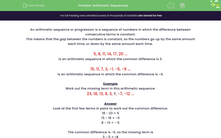An arithmetic sequence or progression is a sequence of numbers in which the difference between consecutive terms is constant.
This means that the gap between the numbers is constant, so the numbers go up by the same amount each time, or down by the same amount each time.
5, 8, 11, 14, 17, 20 ...
is an arithmetic sequence in which the common difference is 3.
15, 11, 7, 3, -1, -5, -9 ...
is an arithmetic sequence in which the common difference is -4.
Example
Work out the missing term in this arithmetic sequence:
23, 18, 13, 8, 3, ?, -7, -12 ...
Answer
Look at the first few terms in pairs to work out the common difference.
18 - 23 = -5
13 - 18 = -5
8 - 13 = - 5
The common difference is -5, so the missing term is
3 - 5 = -2
Once you've worked out your missing term, it is always a good idea to check that the sequence works when this term is added to it.
This makes sure that you don't make a silly mistake!

Let's get started!








